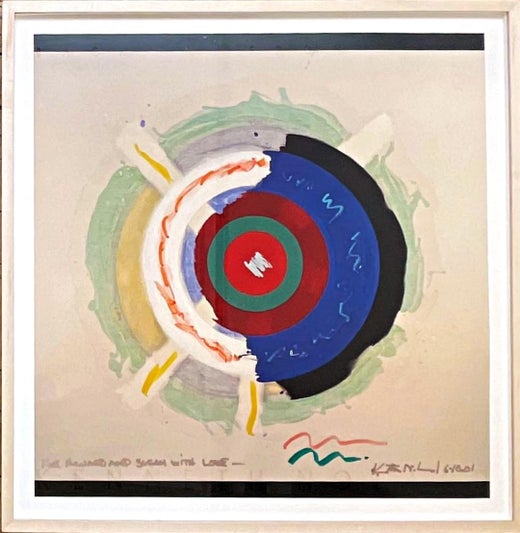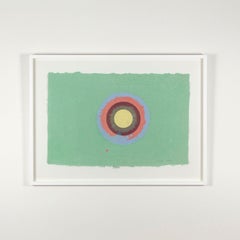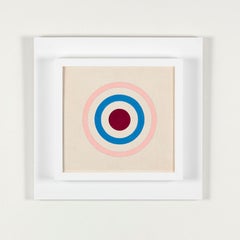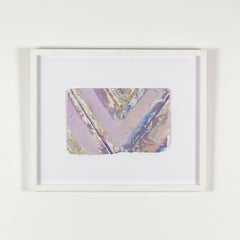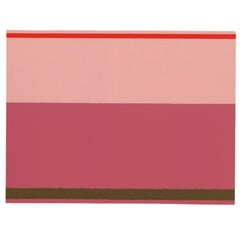Want more images or videos?
Request additional images or videos from the seller
1 of 14
Kenneth NolandUntitled (Circle)2009
2009
$23,000List Price
About the Item
- Creator:Kenneth Noland (1924-2010, American)
- Creation Year:2009
- Dimensions:Height: 35.25 in (89.54 cm)Width: 35 in (88.9 cm)
- Medium:
- Movement & Style:
- Period:
- Condition:Very good condition.
- Gallery Location:Toronto, CA
- Reference Number:Seller: 05-241stDibs: LU215214537772
Kenneth Noland
Kenneth Noland was an American painter. He was known as one of the best American color field painters, although in the 1950's he was thought of as an abstract expressionist and in the 1960's as a minimalist painter. He is most famously known for his target paintings. Noland also helped establish the Washington Color School movement.
About the Seller
4.8
Vetted Professional Seller
Every seller passes strict standards for authenticity and reliability
Established in 2009
1stDibs seller since 2015
197 sales on 1stDibs
Typical response time: 9 hours
Authenticity Guarantee
In the unlikely event there’s an issue with an item’s authenticity, contact us within 1 year for a full refund. DetailsMoney-Back Guarantee
If your item is not as described, is damaged in transit, or does not arrive, contact us within 7 days for a full refund. Details24-Hour Cancellation
You have a 24-hour grace period in which to reconsider your purchase, with no questions asked.Vetted Professional Sellers
Our world-class sellers must adhere to strict standards for service and quality, maintaining the integrity of our listings.Price-Match Guarantee
If you find that a seller listed the same item for a lower price elsewhere, we’ll match it.Trusted Global Delivery
Our best-in-class carrier network provides specialized shipping options worldwide, including custom delivery.You May Also Like
Elegy by Jules Olitski, 2002 (abstract blue and yellow screen print)
By Jules Olitski
Located in New York, NY
This 30 color screen print was created at Brand X Editions to commemorate the terrorist attacks of September 11, 2001 in New York City. This print comes directly from the publisher, Lincoln Center Editions...
Category
Early 2000s Color-Field Abstract Prints
Materials
Screen
Color School Hard Edge Geometric Silkscreen by Howard Mehring
By Howard Mehring
Located in Washington, DC
Silkscreen by Washington Color School artist Howard Mehring (1931-1978). Work is printed on thick wove paper circa 1970. Work was originally acquired from artists estate and is uns...
Category
1970s Color-Field Abstract Prints
Materials
Archival Paper
$2,500
H 37 in W 34 in
Homage to Barnett Newman
By Gene Davis
Located in New York, NY
A very good impression of this color screenprint on white wove paper. Signed and numbered 248/250 in pencil by Davis. Based on a series of oil paintings made by Davis, completed afte...
Category
1970s Color-Field Abstract Prints
Materials
Color, Screen
Limited Edition Silkscreen Target on Canvas Tote Bag 1977 by color field artist
By Kenneth Noland
Located in New York, NY
Kenneth Noland
Limited Edition Canvas Tote, 1977
Mixed Media: Silkscreen on Canvas with handles and leather tag. Numbered with ink stamp
15 × 15 inches
Edition 268/500
Plate signed and dated Kenneth Noland and stamp numbered from the edition of 500
Very good vintage condition with handling and creasing (see photos)
This was not commercially marketed but was designed as a prototype with each one stamp numbered. Not too many are around, and very rarely found in such good condition. This work is sold unframed as shown in the first image, but for inspiration only, see a photograph of how one collector framed a different edition of this work - and it looks like a print or painting! (see last image) A true vintage collectors item.
Category
1970s Color-Field Abstract Prints
Materials
Cotton Canvas, Mixed Media, Screen
$5,500
H 15 in W 15 in D 0.3 in
Monograph titled Themes and Variations 1958-2000 (hand signed by Kenneth Noland)
By Kenneth Noland
Located in New York, NY
Kenneth Noland
Themes and Variations 1958-2000 (hand signed by Kenneth Noland), 2002
Softback monograph with stiff wraps (hand signed and dated by Kenneth Noland)
Official hand signe...
Category
Early 2000s Color-Field Abstract Prints
Materials
Paper, Ink, Mixed Media, Lithograph, Offset
Kenneth NolandMonograph titled Themes and Variations 1958-2000 (hand signed by Kenneth Noland), 2002
$880
H 9 in W 11 in D 0.5 in
Mid 1960s abstraction color field silkscreen signed/N Framed famed Indian artist
By Natvar Bhavsar
Located in New York, NY
Natvar Bhavsar
Untitled mid 1960s abstraction, 1967
Silkscreen
Pencil signed, dated and numbered 10/30 by Natvar Bhavsar on the front
Frame included: Elegantly framed in a museum qua...
Category
1960s Color-Field Abstract Prints
Materials
Screen
Natvar BhavsarMid 1960s abstraction color field silkscreen signed/N Framed famed Indian artist, 1967
$2,500
H 15.5 in W 15.5 in D 1 in
Jack Bush at Andre Emmerich (Exhibition invitation postmarked to McNay director)
By Jack Bush
Located in New York, NY
Jack Bush
Jack Bush at Andre Emmerich, 1966
Offset lithograph exhibition poster. Postmarked to McNay Art institute director
22 1/2 × 17 3/4 inches
Unframed
This special mid century modern exhibition...
Category
1960s Color-Field Abstract Prints
Materials
Lithograph, Offset
$1,000
H 22.5 in W 17.75 in
Jacaranda
By Walter Darby Bannard
Located in New York, NY
Walter Darby Bannard
Jacaranda, 1980
Screenprint on Rives BFK Paper
Hand signed, numbered 74/100 and titled on lower front
24 3/4 × 38 inches
Provenance
Bert Gallery, Providence, Rho...
Category
1980s Color-Field Abstract Prints
Materials
Screen
Divided Lands, Signed Contemporary Blue Abstract Color Field Digital Painting
Located in Boston, MA
Divided Lands, Signed Contemporary Blue Abstract Color Field Digital Painting
30" x 30" x 1.5" (HxWxD) Archival Print on Canvas
Hand-signed by the artis...
Category
21st Century and Contemporary Color-Field Abstract Paintings
Materials
Canvas, Digital, Archival Pigment
$400
H 30 in W 30 in D 1.5 in
Monotype w/hand painting, geometric art famed color field painter, signed Framed
By Kenneth Noland
Located in New York, NY
Kenneth Noland
Untitled, 1987
Monotype with hand painting on wove paper
Signed and dated in pencil on the reverse, with the artist's initials blind stamped lower right
Unique
Frame i...
Category
1980s Color-Field Abstract Prints
Materials
Acrylic, Monotype, Screen
Kenneth NolandMonotype w/hand painting, geometric art famed color field painter, signed Framed, 1987
$15,000 Sale Price
25% Off
H 43 in W 31.25 in D 1 in
More From This Seller
View AllSea Foam Circle II
By Kenneth Noland
Located in Toronto, Ontario
Kenneth Noland (1924 – 2010) is one of the most important artists and contributors to the evolution of American abstraction. He is one of the most beloved figures in the Color-Field ...
Category
1970s Color-Field Abstract Prints
Materials
Handmade Paper, Lithograph, Monotype
$17,000 Sale Price
20% Off
Untitled (Painted Book)
By Kenneth Noland
Located in Toronto, Ontario
Kenneth Noland (1924–2010) is one of the most important artists and contributors to the evolution of American abstraction. He is one of the most beloved figures in the Color-Field mo...
Category
1970s Color-Field Abstract Prints
Materials
Linen, Acrylic
Violet Chevron
By Kenneth Noland
Located in Toronto, Ontario
Kenneth Noland (1924 – 2010) is one of the most important artists and contributors to the evolution of American abstraction. He is one of the most beloved and enduring figures in the Color-Field movement.
Unlike many of his contemporaries, such as Helen Frankenthaler and Sam Gilliam, Noland nearly rejected printmaking until later in his career. And once Noland began collaborating with the printmakers at Tyler Graphics (and other studios) he was more interested in using their applications to make unique one-of-a-kind artworks.
This unique and intimately-scaled monotype is an excellent example of Noland's signature forms and aesthetic from the late 1970s/early 1980s. The chevron was a frequently employed motif of his, first debuting around 1963 and realized repeatedly through the years in different styles and medium.
Here, Noland dissolves the strict geometric lines of his signature chevron or pointed "V", overwhelming the structure with color that appears to be either smeared, splattered or scraped. Lavender, pale rose, mauve, cornflower, chartreuse, ocean blue, ivory and pearl shift into and out of each other, yet avoiding the clear-cut stacked triangular outline of his signature chevron arrangement.
Noland's chevrons are some of the most iconic and desirable works in the 20th-century art canon. This piece is a fine example of one of Noland's creations that showcases his ingenuity and mastery of color.
Questions about this piece? Contact us.
Visit our Toronto gallery on Thursdays or by appointment.
"Chevron"
1983...
Category
1980s Color-Field Abstract Prints
Materials
Monotype
Stockholm
By Kenneth Noland
Located in Toronto, Ontario
Kenneth Noland (1924 – 2010) is one of the most important artists and contributors to the evolution of American abstraction. He is one of the most beloved figures in the Color-Field ...
Category
1970s Color-Field Abstract Prints
Materials
Screen
Bravo Pistachio
By Kenneth Noland
Located in Toronto, Ontario
Kenneth Noland (1924 – 2010) is one of the most important artists and contributors to the evolution of American abstraction. He is one of the most beloved and enduring figures in the...
Category
1980s Color-Field Abstract Prints
Materials
Handmade Paper, Monotype
Stipes
By Kenneth Noland
Located in Toronto, Ontario
Kenneth Noland (1924 – 2010) is one of the most important artists and contributors to the evolution of American abstraction. He is one of the most beloved and enduring figures in the...
Category
1980s Color-Field Abstract Prints
Materials
Monotype
$11,500
Recently Viewed
View AllMore Ways To Browse
Braque Si Je Mourais La Bas
Calder 1968
Claude Monet Art Print Poster
Cynthia Archer
Dali Cosmos
Damien Hirst Woodcut
Dancing Cage
David Redfern
Gian Carozzi
Gianni Bertini
Homage To Calder
Jasper Johns Flag
Jewish Pop Art
Joan Miro Barcelona Lithograph
Joan Miro Large
Joan Miro Limited Edition
Joan Mitchell Lithograph
Kenneth Noland Lithograph
